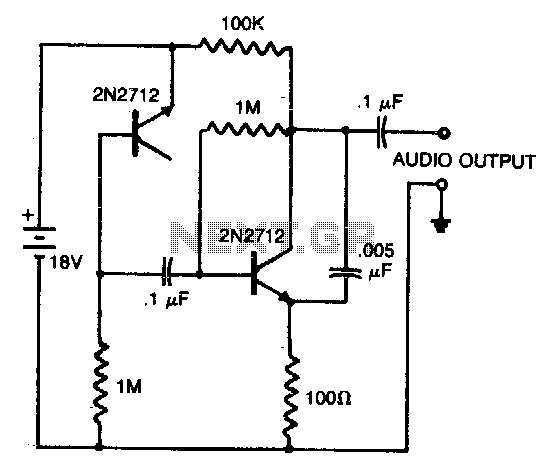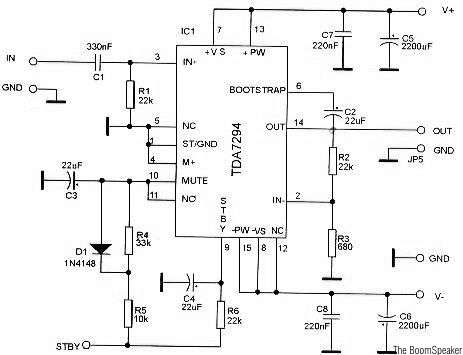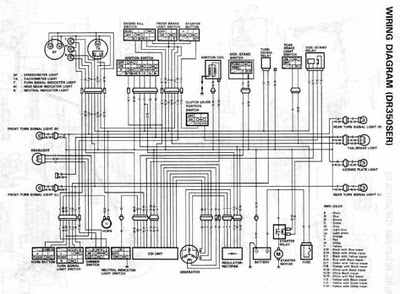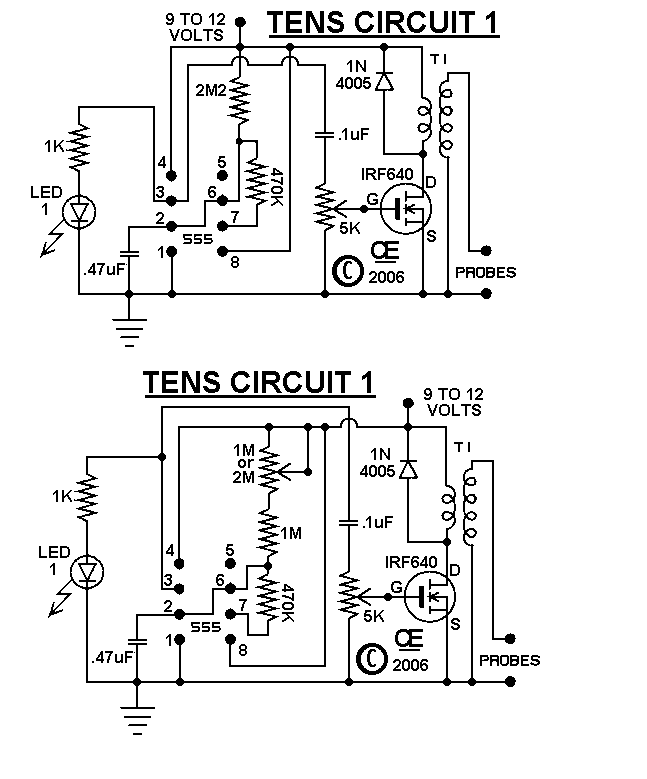
Noise making circuits
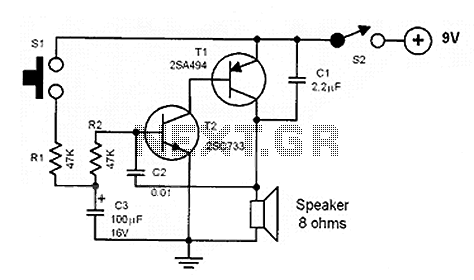
The core of the circuit is a two-transistor flasher with frequency modulation applied to the base of the first transistor. When the pushbutton is pressed, the oscillation frequency increases to a peak, and upon release, the frequency decreases due to the voltage changes across the 22 µF capacitor. The rate of change is determined by the capacitor value and the 100 kΩ resistor connected to the pushbutton. The oscillation eventually ceases if the button is not pressed, leading to minimal current consumption, thus eliminating the need for a power switch. The 0.1 µF capacitor sets the pitch of the siren; using a 0.047 µF capacitor results in a higher pitch, while a 0.001 µF capacitor produces an ultrasonic siren sound in the range of 15 to 30 kHz, which may have an interesting effect on neighborhood dogs. The 33 kΩ resistor connected from the collector of the PNP transistor to the base of the NPN transistor widens the pulse to the speaker, enhancing volume. The flasher circuit drives a PNP transistor that powers the speaker. A small-signal transistor, such as the 2N4403, is typically used in most applications due to its low power dissipation from rapid on-and-off switching. The 100 Ω resistor and the 100 µF capacitor in series with the speaker limit the current to approximately 60 mA, but these components can be replaced with a short circuit for a louder siren, provided the transistor can handle the increased current. The prototype drew about 120 mA when shorted, which is acceptable for the 2N4403. Substitutions for the transistor should be feasible; most small-signal transistors can be used, but high-frequency types should be avoided to prevent unwanted RF oscillations. This circuit simulates a chime similar to the sound produced by many cars when the keys are left in the ignition. The bottom two gates form a square wave audio oscillator that drives the base of the 2N4401, turning it on and off at an audio rate. The top two gates generate a short low-going pulse approximately once per second, discharging the 10 µF capacitor through a diode. The voltage then rises sharply and decays slowly through a 15 kΩ collector resistor when the 2N4401 is conducting. The result is a square wave at the collector of the 2N4401 that rises quickly and decays slowly. A Darlington emitter-follower buffers the square wave and drives a small speaker. The tone frequency is determined by the 1000 pF capacitor, and the chime's cadence is regulated by the 0.1 µF capacitor. The 10 µF capacitor controls how quickly the chime fades out, while the 3.3 kΩ and 3.3 µF components soften the attack time of the leading edge of the chime. Volume is adjusted using a 22 Ω resistor in conjunction with a 100 µF bypass capacitor. These component values may be varied experimentally to achieve the desired sound characteristics.
The described circuit operates as a versatile audio signaling device, suitable for various applications where sound alerts are required. The two-transistor flasher mechanism allows for dynamic frequency modulation, resulting in a customizable audio output. The interaction between the capacitors and resistors plays a crucial role in defining the sound's characteristics, including pitch, volume, and decay time. The choice of transistors also impacts performance; therefore, selecting appropriate small-signal transistors ensures reliability and efficiency. The circuit's design allows for easy adjustments, making it adaptable to different sound requirements. The use of a Darlington pair for buffering enhances the output drive capability, ensuring that the speaker receives sufficient power to produce audible tones. The overall design emphasizes low power consumption during idle states, which is particularly advantageous for battery-operated devices. By modifying component values, users can experiment with various sound profiles, making this circuit a valuable tool for creating sound alerts in automotive applications, alarms, or novelty devices.The heart of the circuit is the two transistor flasher with frequency modulation applied to the base of the first transistor. When the pushbutton is depressed, the frequency of oscillation climbs to a peak and when the button is released, the frequency descends due to the rising and falling voltage on the 22 uF capacitor.
The rate of change is det ermined by the capacitor value and the 100k resistor from the pushbutton. The oscillation eventually stops if the button is not depressed and the current consumption drops to a tiny level so no power switch is needed. The 0. 1 uF determines the pitch of the siren: A 0. 047uF will give a higher pitch siren and a 0. 001 uF will give an ultrasonic (at least for me, anyway) siren from 15 to 30 kHz which might have an interesting effect on the neighborhood dogs!
The 33k resistor from the collector of the PNP to the base of the NPN widens the pulse to the speaker giving greater volume. The flasher circuit drives a PNP transistor which powers the speaker. This transistor may be a small-signal transistor like the 2N4403 in most applications since it will not dissipate much power thanks to the rapid on-and-off switching.
The 100 ohm and 100uF capacitor in series with the speaker limit the current to about 60 mA and they may be replaced with a short circuit for a louder siren as long as the transistor can take the increased current. The prototype drew about 120 mA when shorted which is fine for the 2N4403. Transistor substitutions should be fine - try just about any small-signal transistors but avoid high frequency types so that you do not end up with unwanted RF oscillations.
This circuit simulates a chime similar to the sound many cars make when the keys are left in the ignition. The bottom two gates form a squarewave audio oscillator that drives the base of the 2N4401, turning it on and off at an audio rate.
The top two gates produce a short low-going pulse about once per second that discharges the 10 uF capacitor through the diode. The voltage then jumps up and slowly decays through the 15 k collector resistor when the 2N4401 is conducting.
The result is a squarewave on the collector of the 2N4401 that jumps up quickly then decays slowly. The darlington emitter-follower buffers the squarewave and drives a small speaker. The tone frequency is set by the 1000 pF capacitor and the cadence of the chime is set by the 0. 1 uF capacitor. The 10 uF capacitor determines how quickly the chime dies out and the 3. 3 k/3. 3 uF soften the attack time of the leading edge of the chime. The volume is set by the 22 ohm resistor and 100 uF bypass capacitor. These values may be experimentally varied to produce the desired sound. 🔗 External reference
The described circuit operates as a versatile audio signaling device, suitable for various applications where sound alerts are required. The two-transistor flasher mechanism allows for dynamic frequency modulation, resulting in a customizable audio output. The interaction between the capacitors and resistors plays a crucial role in defining the sound's characteristics, including pitch, volume, and decay time. The choice of transistors also impacts performance; therefore, selecting appropriate small-signal transistors ensures reliability and efficiency. The circuit's design allows for easy adjustments, making it adaptable to different sound requirements. The use of a Darlington pair for buffering enhances the output drive capability, ensuring that the speaker receives sufficient power to produce audible tones. The overall design emphasizes low power consumption during idle states, which is particularly advantageous for battery-operated devices. By modifying component values, users can experiment with various sound profiles, making this circuit a valuable tool for creating sound alerts in automotive applications, alarms, or novelty devices.The heart of the circuit is the two transistor flasher with frequency modulation applied to the base of the first transistor. When the pushbutton is depressed, the frequency of oscillation climbs to a peak and when the button is released, the frequency descends due to the rising and falling voltage on the 22 uF capacitor.
The rate of change is det ermined by the capacitor value and the 100k resistor from the pushbutton. The oscillation eventually stops if the button is not depressed and the current consumption drops to a tiny level so no power switch is needed. The 0. 1 uF determines the pitch of the siren: A 0. 047uF will give a higher pitch siren and a 0. 001 uF will give an ultrasonic (at least for me, anyway) siren from 15 to 30 kHz which might have an interesting effect on the neighborhood dogs!
The 33k resistor from the collector of the PNP to the base of the NPN widens the pulse to the speaker giving greater volume. The flasher circuit drives a PNP transistor which powers the speaker. This transistor may be a small-signal transistor like the 2N4403 in most applications since it will not dissipate much power thanks to the rapid on-and-off switching.
The 100 ohm and 100uF capacitor in series with the speaker limit the current to about 60 mA and they may be replaced with a short circuit for a louder siren as long as the transistor can take the increased current. The prototype drew about 120 mA when shorted which is fine for the 2N4403. Transistor substitutions should be fine - try just about any small-signal transistors but avoid high frequency types so that you do not end up with unwanted RF oscillations.
This circuit simulates a chime similar to the sound many cars make when the keys are left in the ignition. The bottom two gates form a squarewave audio oscillator that drives the base of the 2N4401, turning it on and off at an audio rate.
The top two gates produce a short low-going pulse about once per second that discharges the 10 uF capacitor through the diode. The voltage then jumps up and slowly decays through the 15 k collector resistor when the 2N4401 is conducting.
The result is a squarewave on the collector of the 2N4401 that jumps up quickly then decays slowly. The darlington emitter-follower buffers the squarewave and drives a small speaker. The tone frequency is set by the 1000 pF capacitor and the cadence of the chime is set by the 0. 1 uF capacitor. The 10 uF capacitor determines how quickly the chime dies out and the 3. 3 k/3. 3 uF soften the attack time of the leading edge of the chime. The volume is set by the 22 ohm resistor and 100 uF bypass capacitor. These values may be experimentally varied to produce the desired sound. 🔗 External reference
